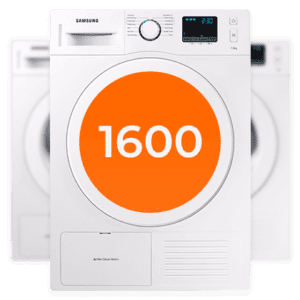1600 RPM washing machine
Before we tell you more about this type of washing machine, let’s take a closer look at what a RPM is. The RPM of a washing machine tells you how many rounds the drum spins per minute while it is spinning. The higher the RPM, the faster the drum turns, the drier your laundry will be.
If you want your laundry to be as dry as possible, choose a 1600 RPM washing machine. This is referred to as a ‘high rpm’ washing machine. 1400 rpm is also considered a high number of revolutions, but it means that your laundry stays slightly wetter. A 1600 rpm washing machine has a residual moisture percentage of 44%, while a 1400 rpm washing machine has a residual moisture percentage of 50%. In both cases you will have to hang up your laundry or put it in the dryer, but at 1600 rpm (rounds per minute) this takes less time. Also, your dryer will not have to work as hard to get your laundry completely dry.
Most washing machines are rated at 1400 rpm. Therefore, this option is the most commonly chosen. However, if you don’t have a dryer, a 1600 rpm is very nice.
If you don’t care about the rpm of your washer, you can also choose 1200 rpm or less. This might be an option for you if you are putting your laundry in the dryer anyway.
Best 1600 RPM washing machine of 2024
Want to know what the best 1600 RPM washing machines of 2024 are? We have compared several washing machines that all run at 1600 rpm, to come up with a list of the best models at the moment. We’ve looked at factors like product weight, noise level, different wash cycles, energy rating and customer reviews. Is your new 1600 rpm washing machine among them?
Buying 1600 RPM Washers: What to Look Out For
Washers are very comprehensive appliances, with many options and specifications. RPM is important, but there are many other things to consider when buying a new washing machine. There are two different types of washing machines: the front loading washer and the top loading washer. The front loading washer is the most common and the most popular. It has the door at the front of the drum, so you can put a dryer on top of it.
The top loading washer has the door at the top. These models also tend to be a bit narrower and taller, so you don’t have to bend over as much. However, 1600 rpm washing machines are almost always front loading.
Fill Weight
How many kg of laundry fits in the drum is indicated by the fill weight. This is also known as the capacity of the washing machine. Exactly how much fill weight you need depends on several things, but the number of people you share the washing machine with plays the biggest role – i.e. the size of your household. For this reason, the wash weight is one of the most important things to consider when buying a new washing machine.
If you are a one or two person household, a 6 or 7kg washing machine is best. If you are a 3 or 4 person household, an 8kg machine would be better. Do you have a household of 5 or more? Then we recommend you look at washing machines with 9 or 10 kg fills. Other reasons to go for more capacity might be because you do a lot of sport or wash more often due to allergies.
Energy class
If you want to save on your energy bill, choose an energy-efficient washing machine. These are definitely also available with a 1600 rpm speed. Of course, a washing machine uses more energy the harder it spins. However, most energy is used to heat the water. This is where manufacturers cut back on when making their washing machines more energy efficient. The terms ‘energy class’ and ‘energy label’ are often used interchangeably. But they mean the same thing. If you want an energy-efficient washing machine with 1600 rpm, you should look at whether they have energy class A, B or C. A washing machine with energy class A uses the least energy per wash. Efficient washing machines are often more expensive to buy, but in use, they save you money by keeping your energy bill low. They are also better for the environment. Win-win!
Split noise level
The noise level of a washing machine measures how much noise it makes when it is at its loudest – during a spin. This is indicated in decidel (dB). You’d almost think that a high-rpm washing machine would automatically fall into the ‘loud washing machines’ group, but that’s not necessarily true. There are several reasons why some washing machines are quieter than others. This can indeed be due to the RPM, but also to the type of motor, the quality of materials and whether the washing machine has dampers.
Loud washing machines produce 78 dB or more. 74 dB to 77 dB is considered “normal” for a washing machine. Appliances that produce 72 dB or 73 dB fall under the category of ‘quiet washing machines’ and if they generate 71 dB or less of noise, they are ‘extra quiet’. Most 1600 RPM washing machines are rated “Normal” or “Extra Quiet”.
If your washing machine is going to be in a shed or in the attic, you don’t need to pay much attention to the noise level. But if you put it in an open-plan kitchen or a room next to a bedroom, you won’t want your washer to be louder than 73 dB.
Ease of Use
Washers are offering more and more options to make washing easier – so that every wash is a snap. These include a load sensor, delayed start, add wash, a self-cleaning detergent drawer, automatic detergent dosing and control via an app. Do you want washing to be a breeze? Because everyone has different needs, there are many different wash programmes. If you have a need for certain wash programs, make sure that the washing machine you buy offers them. There are special programs for delicate fabrics, stains, sportswear, baby clothes, extra hygienic washing and shirts, among others. Be aware, however, that the high RPM of 1600 can often only be used for cotton laundry programmes. For other laundry, it is best not to use a high RPM machine, otherwise your garments may not last as long.
Preferences and disadvantages 1600 rpm
If you are considering a 1600 rpm washing machine, the only competitor is a 1400 rpm washing machine. Most washing machines sold today have such a high rpm. But what exactly are the differences? And which one is better? We would like to explain the advantages and disadvantages of the 1600 rpm washing machine.
Advantages
The main advantage of a 1600 rpm washing machine over a 1400 rpm washing machine is that your laundry comes out drier. At 1600 rpm you will have a residual moisture percentage of 44%, while at 1400 rpm it will be 50%. In both cases, you can let your laundry air dry further. The difference isn’t huge, but at 1600 rpm your laundry won’t have to hang around as long. Besides, if you do decide to put your clothes or bedding in the dryer, your dryer won’t have to work as hard to get it completely dry. Which is nice, because dryers generally use more energy than washing machines.
One other thing: if you do want to wash at a lower speed, you can always do so. Most washing machines allow you to adjust the spin speed for each wash cycle.
Disadvantages
Because the washing machine has to work harder when spinning, it uses more energy. How much more energy this is varies from washer to washer. There are plenty of 1600 rpm washing machines with energy classes A, B and C. Energy class C already counts as an energy-efficient washing machine.
In addition, your laundry tends to wrinkle more when you wash it at a higher speed. At 1400 rpm or lower this will be less.
And finally, there are more washing machines with a maximum of 1400 rpm. So if you go for a (slightly) lower rpm, you do have a lot more choice right away. The number of washing machines that can run at 1600 rpm is getting larger.

